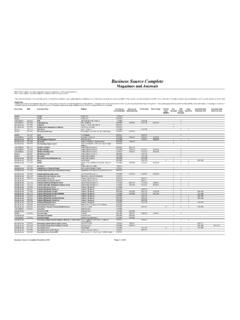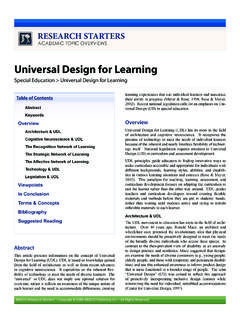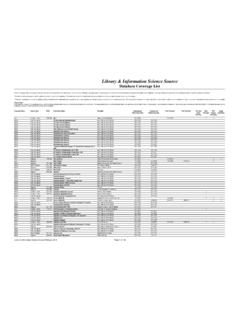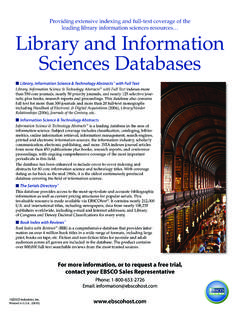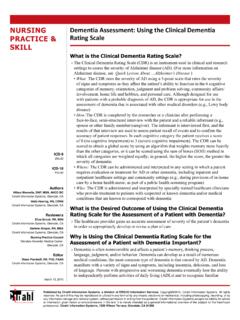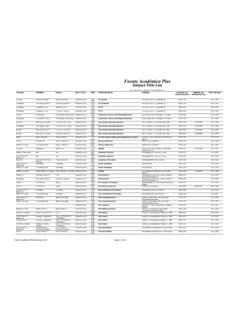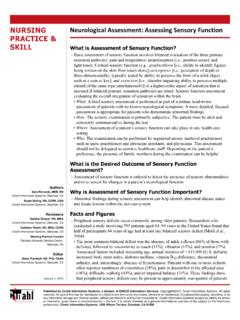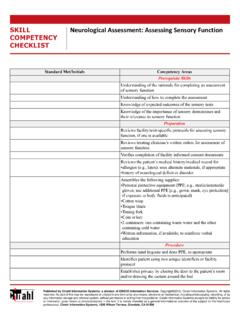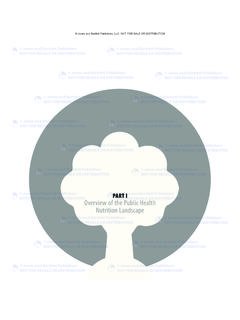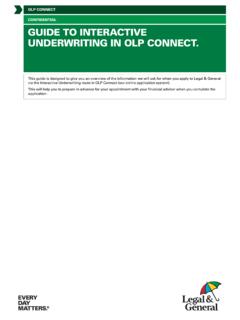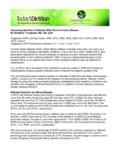Transcription of Description/Etiology LESSON Embolism, Air, in the …
1 E. Beddoe, RN, PhDCinahl Information Systems, Glendale, CATanja Schub, BSCinahl Information Systems, Glendale, CAReviewersEliza Schub, RN, BSNC inahl Information Systems, Glendale, CATeresa-Lynn Spears, RN, BSN, PHN, AE-CCinahl Information Systems, Glendale, CANursing Practice CouncilGlendale Adventist Medical Center,Glendale, CAEditorDiane Pravikoff, RN, PhD, FAANC inahl Information Systems, Glendale, CAJanuary 1, 2016 Published by Cinahl Information Systems, a division of EBSCO Information Services. Copyright 2015, Cinahl Information Systems. All rightsreserved. No part of this may be reproduced or utilized in any form or by any means, electronic or mechanical, including photocopying, recording, or byany information storage and retrieval system, without permission in writing from the publisher.
2 Cinahl Information Systems accepts no liability for adviceor information given herein or errors/omissions in the text. It is merely intended as a general informational overview of the subject for the healthcareprofessional. Cinahl Information Systems, 1509 Wilson Terrace, Glendale, CA 91206 Embolism, Air, in the NewbornDescription/EtiologyAn air embolism (AE) is an air bubble trapped in a blood vessel, obstructing blood in the newborn is a rare but life-threatening event that typically results in hemodynamiccollapse, multiorgan failure, and order for an AE to form, two conditions must exist: there must be a direct communicationbetween the vasculature and an air source ( , the lung or gastrointestinal tract) andthere must be a pressure differential that favors the passage of air into the circulationrather than bleeding from the vessel.
3 The most common cause of AE in newborns ispositive-pressure ventilation, which can cause barotrauma to the lungs ( , alveolarrupture due to elevated transalveolar pressure), allowing for entry of air into the pulmonaryvasculature. Other causes of AE in this patient population include necrotizing enterocolitis( , a life-threatening condition characterized by acute mucosal necrosis of the intestines;for more information, see Quick LESSON About .. Enterocolitis, Necrotizing, in PrematureInfants ), surgical procedures ( , neurosurgery, cardiac surgery), medical procedures( , umbilical vein and catheterization, epidural procedures, neonatal resuscitation,injections during resuscitation, peripheral infusion), and is no specific treatment for AE.
4 Following initial resuscitation, intensive supportivecare is provided, including careful monitoring, administration of medications and volumeexpanders, and lowering of ventilatory pressures as much as possible to allow the neonate slungs to heal. Provision of emotional support to the parents/family members is critical andcan be accomplished by allowing parents to hold or be physically close to their newborn,explaining all procedures and their purpose, and requesting a referral to a mental healthclinician and social worker. Strategies for prevention of AE in the newborn includecarefully following guidelines for neonatal resuscitation, minimizing airway pressures inmechanically ventilated patients to prevent pulmonary barotrauma, careful insertion of linesinto the circulatory system, locking adaptors on all lines, filling tubing completelywith solution, use of an air detection alarm on an infusion pump, and replacing leakingor open infusion and FiguresAE in newborns is extremely rare; data on incidence are not available.
5 Just 7 cases of AEin infants due to peripheral infusion have been documented in the English-languageliterature. AE is almost invariably fatal; there are just a few reported cases of patientssurviving the FactorsRisk factors for AE in the newborn include mechanical ventilation (usually due torespiratory distress syndrome; for more information, see Quick LESSON About ..Respiratory Distress Syndrome, Neonatal ), necrotizing enterocolitis, insertion of centralvenous lines, intravenous injections, and cardiopulmonary resuscitation. Premature infantsare at increased risk for developing ventilator-associated and Symptoms/Clinical PresentationClinical signs of AE include dyspnea; palpitations; tachypnea; weak, rapid pulse; increased central venous pressure;hypotension; loss of consciousness.
6 And Physical Findings of Particular Interest Air popping in the heart may be audible on chest auscultation Laboratory Tests That May Be Ordered ABGs will indicate hypoxemia (which may be severe) and hypercapnia Blood tests may reveal platelets and/or serum creatine kinase activity Other Diagnostic Tests/Studies EKG likely reveals sinus tachycardia, right heart strain, nonspecific ST-segment and T-wave changes, and acutemyocardial ischemia or infarction X-rays may reveal the presence of air within intravascular structures; chest X-rays may show pulmonary edema Echocardiograph may show one or more air bubbles within the heart chambers CT scan may confirm the presence of AE in the heart chambers, peripheral vessels, and/or the vessels of the brainTreatment Goals Assist with Resuscitation, Carefully Monitor Patient, and Provide Intensive Supportive Care Assist with resuscitation, as appropriate Administer supplemental oxygen, as prescribed Continuously monitor vital signs and pulse oximetry, assess all physiologic systems, and review laboratory/diagnosticstudy results.
7 Immediately report abnormalities to the treating clinician Carefully monitor ventilation and initiate changes in ventilatory pressure, as ordered Administer blood volume expanders to correct hypotension Administer prescribed sedatives, inotropics, and/or nitric oxide (NO), as ordered Monitor treatment efficacy and for adverse effects of all medications administered Suction gently, if ordered, as infrequently as possible to improve airway patency Maintain conservation of heat within a neutral thermal environment Closely monitor intake and output; provide parenteral nutrition, fluids, and/or blood transfusions, as ordered, andfrequently assess for edema/other complications Provide Emotional/Psychological Support and Educate Assess parent/family member anxiety level and coping ability; educate about AE in the newborn, potential complications,treatment risks/benefits, and individualized prognosis Provide emotional support to the parents/family members and demonstrate how to hold or be physically close to thenewborn.
8 Keep parents updated about the neonate s status Request referral, if appropriate, to a mental health clinician or clergyperson for supportive counseling and a social workerfor identification of local resources or support groups for bereavementFood for Thought AE may be underdiagnosed in the newborn for several reasons. Postmortem X-rays and autopsy may be unable to detect AEbecause intravascular air is rapidly absorbed and disappears within a half hour after deathRed Flags Signs of cerebral arterial gas embolism include seizure, focal, neurological deficits, depressed consciousness, and cardiacarrhythmiasWhat Do I Need to Tell the Patient s Family? Provide parents with realistic, clear, and factual information about their newborn s condition Request referral to a clergyperson and/or mental health clinician for grief support and counseling, if , P.
9 , Halbertsma, F., van Lijnschoten, G., Weerdenburg, H., & Bambang Oetomo, S. (2008). Systemic air embolism after cardiopulmonary resuscitation in a preterminfant. Acta Paediatrica, 97(6), , G., & Perotti, G. (2009). Air embolism in the newborn: Rare complication of intensive care therapy in children. American Journal of Perinatology, 26(5), , F. J., & Andriessen, P. (2009). Cerebral air embolism in a neonate following cardiopulmonary resuscitation. Pediatric Radiology, 39(1), , , Lee, , Tsao, , & Soong, (2012). Neonatal air leak syndrome and the role of high-frequency ventilation in its prevention. Journal of the ChineseMedical Association, 75(11), 551-559. , A., Lu, C. K., Wang, S., Umstead, T.
10 M., Freeman, W. M., Vrana, K., & Undar, A. (2009). Pediatric cardiopulmonary bypass circuits: A review of studies conducted at thePenn State Pediatric Cardiac Research Laboratories. The Journal of Extra-Corporeal Technology, 41(1), , M. (2014). Fluid and electrolytes: Balance and disturbance. In J. L. Hinkle & K. H. Cheever (Eds.), Brunner & Suddarth's textbook of medical-surgical nursing (13th ed.,Vol. 1, p. 280). Philadelphia, PA: Wolters Kluwer Health/Lippincott Williams and , A. Q., Haider, Z. A., & Najam, Y. (2015). Fatal systemic air embolism in a neonate after cardiopulmonary resuscitation. APSP Journal of Case Reports, 6(1), , M. W., Lovelady, C. L., Brogdon, B. G., & Wecht, C. H. (2007).
